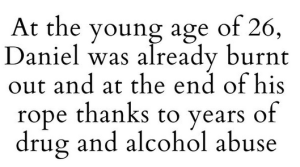Based on what I’ve learnt about beginnings, plot and character this week, here I lay out a simple lesson plan introducing the power of short story beginnings into the foreign language classroom:
Materials
A large copy of the text above with words missing, as mentioned in the Warmer below (for example, in ppt form).
A large copy of the completed text above, as mentioned in the Warmer below (for example, in ppt form).
Make enough copies of the ‘7 ingredients for a Good Beginning‘ for each group of 3-4 ss in the class. Cut up each copy into seven pieces.
Warmer
T boards the text above, with selected words missing. For example,
“At the young age of ___, Daniel was already ____ ____ and at the end of his ____ thanks to years of drug and ____ abuse”.
T invites the ss to read the text chorally.
T asks ss to work in pairs and fill in the gaps with as many different possibilities in 5 minutes. T encourages them to be as creative as possible.
Pairs take it in turns to read aloud their version. T organises a vote for the best suggestions. T provides the completed text on the board.
Lead In
T organises a ‘game of speed’ and asks ss to count the number of words in the text. Group feedback.
T asks the ss what we learn about the main character, and what, if any, assumptions we can make about his life. T encourages to be creative and make intelligent guesses. Group discussion.
T asks ss to reflect on how a short number of words can stimulate the imagination
Vocabulary Extension
T focuses on two lexis points: ‘burnt out (someone)‘ and ‘at the end of your rope‘.
T asks ss to change seats so they are working in different pairs.
Each pair uses their own mobile device to find out the dictionary definitions and synonyms of these two phrases.
T asks ss to swap their synonyms into the text, and practice reading the sentence aloud.
Pairs take it in turns to read aloud their version to the class.
T asks ss to reflect on how similar words can have different meanings in different contexts. Group discussion on the importance of phrasal verbs and idioms in language learning.
Reading & Speaking Activity 1
T asks ss already in their new pairs to work with another pair.
T hands out seven slips of paper (7 ingredients for Good Beginnings) to each group and asks the ss to spread them on the table, face down.
T asks ss to turn them over one by one, have each st read the sentence aloud, find the common theme, and put the sentences in order. (FYI – there is no correct order).
T monitors and provides individual correction and feedback.
Group feedback.
Reading & Speaking Activity 2
T asks the groups to analyse the original text with regards to the 7 ingredients for a Good Beginning.
T may ask: what ingredients are present in the original text? What ingredients are missing?
Group discussion.
Delayed error correction*
Writing Activity
T asks ss to work in pairs again and add a few sentences to the original text which incorporate the missing ingredients.
T monitors and makes notes of any systematic lexical or grammatical errors.
Delayed error correction. (T asks ss to make corrections to their work)
T collects the ss work and sticks each short story up on the classroom walls.
T asks ss to work around and read the stories.
T asks to comment on the stories they like best and why.
Homework
T asks to choose a person as the main character, for example – best friend, family member, and use the 7 basic ingredients to write a beginning, with as few a number of words as possible.
My Thoughts
Wow! It’s clear here, that from the smallest of input, you can extrapolate so much learning! I’m sure I’ve only just touched the surface of all the possible activities you can do with one sentence! On the other hand, my use of technology in this lesson plan leaves a lot to be desired. I would like to integrate it more more to enhance the understanding of beginnings and plot, but I suddenly hit a brick wall. Dear readers, do you have any ideas?
Delayed error correction = T monitors ss unobtrusively so as not to disturb the work flow. T makes notes of any vocabulary or grammar errors she hears/reads. T makes a note of these errors on the board/on a ppt. T asks ss as a group to spot the error and correct the error. Group discussion.
Here is a great resource that gives six alternative suggestions for giving delayed error correction



You are right, so many possibilities from just a couple of sentences!
This is a very creative lesson plan and I am sure students would enjoy the class. Let us know if you ever use it and about your students’ response. Keep these ideas in mind, keep thinking of how technology could be incorporated and we’ll talk about it after Easter. So much to look forward to!